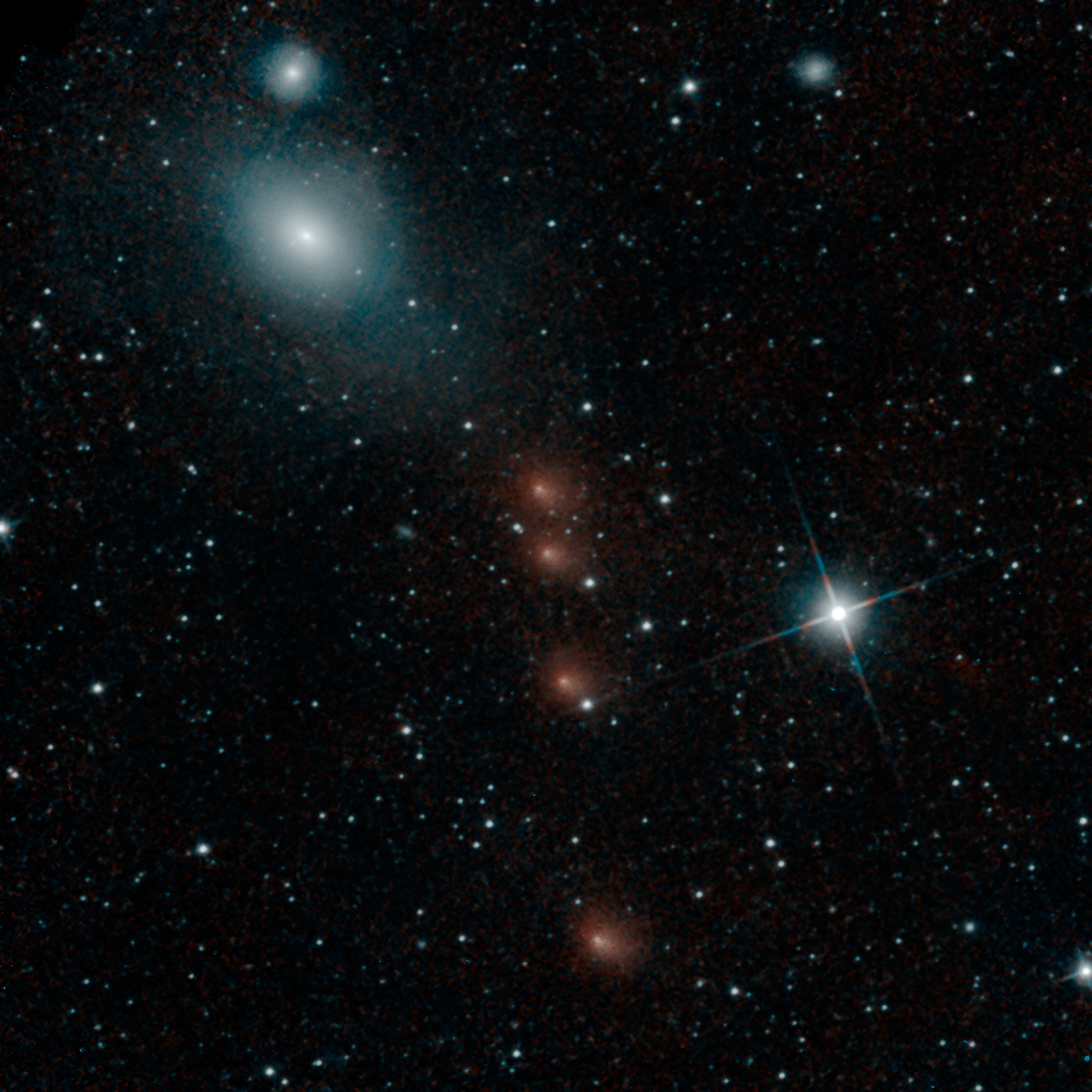|
1655 Comas Solà
1655 Comas Solà, provisional designation , is a rare-type asteroid from the central region of the asteroid belt, approximately 36 kilometers in diameter. It was discovered on 28 November 1929, by Spanish astronomer of Catalan origin, Josep Comas i Solà at the Fabra Observatory in Barcelona, Spain. It was later named after the discoverer. Orbit and classification It orbits the Sun in the central main-belt at a distance of 2.1–3.4 AU once every 4 years and 8 months (1,693 days). Its orbit has an eccentricity of 0.24 and an inclination of 10 ° with respect to the ecliptic. It was first observed as at Heidelberg Observatory in 1901, extending the body's observation arc by 28 years prior to its official discovery observation at Barcelona. Physical characteristics ''Comas Solà'' shows as rare XFU-type and B-type spectrum in the Tholen and SMASS classification scheme, respectively. Lightcurves A rotational lightcurve obtained by American amateur astronomer Rob ... [...More Info...] [...Related Items...] OR: [Wikipedia] [Google] [Baidu] |
Josep Comas I Solà
Josep Comas i Solà (; Barcelona 17 December 1868 – 2 December 1937) was a Spanish ( Catalan) astronomer, discoverer of minor planets, comets, and double stars. He wrote his first astronomy notes at the age of ten, and was only fifteen when he published an article in a French specialist magazine.Baedeker's Barcelona Peter M. Nahm, Automobile Association (Great Britain) - 1992 "Josep Comas i Solà (1868–1937) Born in Barcelona, Josep Comas i Sola soon made his mark as an astronomer; he was only fifteen when he published an article in a French specialist magazine. " He observed planets including Mars and Saturn, measuring the rotation period of the latter. He wrote some books popularizing astronomy, and was first president of the Spanish and American Astronomical Society (; S.A.D.E.Y.A.). He discovered the periodic comet 32P/Comas Solà, and co-discovered the non-periodic comet C/1925 F1 (Shajn-Comas Solà); he is also credited by the Minor Planet Center with the discover ... [...More Info...] [...Related Items...] OR: [Wikipedia] [Google] [Baidu] |
Orbital Inclination
Orbital inclination measures the tilt of an object's orbit around a celestial body. It is expressed as the angle between a reference plane and the orbital plane or axis of direction of the orbiting object. For a satellite orbiting the Earth directly above the Equator, the plane of the satellite's orbit is the same as the Earth's equatorial plane, and the satellite's orbital inclination is 0°. The general case for a circular orbit is that it is tilted, spending half an orbit over the northern hemisphere and half over the southern. If the orbit swung between 20° north latitude and 20° south latitude, then its orbital inclination would be 20°. Orbits The inclination is one of the six orbital elements describing the shape and orientation of a celestial orbit. It is the angle between the orbital plane and the plane of reference, normally stated in degrees. For a satellite orbiting a planet, the plane of reference is usually the plane containing the planet's equator. For pla ... [...More Info...] [...Related Items...] OR: [Wikipedia] [Google] [Baidu] |
Astronomical Albedo
Albedo ( ; ) is the fraction of sunlight that is diffusely reflected by a body. It is measured on a scale from 0 (corresponding to a black body that absorbs all incident radiation) to 1 (corresponding to a body that reflects all incident radiation). ''Surface albedo'' is defined as the ratio of radiosity ''J''e to the irradiance ''E''e (flux per unit area) received by a surface. The proportion reflected is not only determined by properties of the surface itself, but also by the spectral and angular distribution of solar radiation reaching the Earth's surface. These factors vary with atmospheric composition, geographic location, and time (see position of the Sun). While directional-hemispherical reflectance factor is calculated for a single angle of incidence (i.e., for a given position of the Sun), albedo is the directional integration of reflectance over all solar angles in a given period. The temporal resolution may range from seconds (as obtained from flux measurements) to ... [...More Info...] [...Related Items...] OR: [Wikipedia] [Google] [Baidu] |
NEOWISE
Wide-field Infrared Survey Explorer (WISE, observatory code C51, Explorer 92 and MIDEX-6) was a NASA infrared astronomy space telescope in the Explorers Program launched in December 2009.. . WISE discovered thousands of minor planets and numerous star clusters. Its observations also supported the discovery of the first Y-type brown dwarf and Earth trojan asteroid. ... . WISE performed an all-sky astronomical survey with images in 3.4, 4.6, 12 and 22 μm wavelength range bands, over ten months using a diameter infrared telescope in Earth orbit. After its solid hydrogen coolant depleted, it was placed in hibernation mode in February 2011. In 2013, NASA reactivated the WISE telescope to search for near-Earth objects (NEO), such as comets and asteroids, that could collide with Earth. The reactivation mission was called Near-Earth Object Wide-field Infrared Survey Explorer (NEOWISE). As of August 2023, NEOWISE was 40% through the 20th coverage of the full sky. Science o ... [...More Info...] [...Related Items...] OR: [Wikipedia] [Google] [Baidu] |
Wide-field Infrared Survey Explorer
Wide-field Infrared Survey Explorer (WISE, List of observatory codes, observatory code C51, Explorer 92 and MIDEX-6) was a NASA infrared astronomy Space observatory, space telescope in the Explorers Program launched in December 2009.. . WISE List of minor planet discoverers#WISE, discovered thousands of minor planets and numerous star clusters. Its observations also supported the discovery of the first Y dwarf, Y-type brown dwarf and Earth trojan, Earth trojan asteroid. ... . WISE performed an all-sky astronomical survey with images in 3.4, 4.6, 12 and 22 μm wavelength range bands, over ten months using a diameter infrared telescope in Geocentric orbit, Earth orbit. After its solid hydrogen coolant depleted, it was placed in Hibernation (spaceflight), hibernation mode in February 2011. In 2013, NASA reactivated the WISE telescope to search for near-Earth objects (NEO), such as comets and asteroids, that could collide with Earth. The reactivation mission was called Near-Eart ... [...More Info...] [...Related Items...] OR: [Wikipedia] [Google] [Baidu] |
Akari (satellite)
AKARI (ASTRO-F) was an infrared astronomy satellite developed by Japan Aerospace Exploration Agency, in cooperation with institutes of Europe and Korea. It was launched on 21 February 2006, at 21:28 UTC (06:28, 22 February JST) by M-V rocket into Earth Sun-synchronous orbit. After its launch it was named ''AKARI'' (明かり), which means ''light'' in Japanese. Earlier on, the project was known as IRIS (InfraRed Imaging Surveyor). Its primary mission was to survey the entire sky in near-, mid- and far-infrared, through its aperture telescope. Technical design Its designed lifespan, of far- and mid-infrared sensors, was 550 days, limited by its liquid helium coolant. Its telescope mirror was made of silicon carbide to save weight. The budget for the satellite was ¥13,4 billion (~). History By mid-August 2006, AKARI finished around 50 per cent of the all sky survey. By early November 2006, first (phase-1) all-sky survey finished. Second (phase-2) all-sky survey starte ... [...More Info...] [...Related Items...] OR: [Wikipedia] [Google] [Baidu] |
LCDB Quality Code
In astronomy, a light curve is a graph of the light intensity of a celestial object or region as a function of time, typically with the magnitude of light received on the ''y''-axis and with time on the ''x''-axis. The light is usually in a particular frequency interval or band. Light curves can be periodic, as in the case of eclipsing binaries, Cepheid variables, other periodic variables, and transiting extrasolar planets; or aperiodic, like the light curve of a nova, cataclysmic variable star, supernova, microlensing event, or binary as observed during occultation events. The study of a light curve and other observations can yield considerable information about the physical process that produces such a light curve, or constrain the physical theories about it. Variable stars Graphs of the apparent magnitude of a variable star over time are commonly used to visualise and analyse their behaviour. Although the categorisation of variable star types is increasingly ... [...More Info...] [...Related Items...] OR: [Wikipedia] [Google] [Baidu] |
Magnitude (astronomy)
In astronomy, magnitude is a measure of the brightness of an astronomical object, object, usually in a defined passband. An imprecise but systematic determination of the magnitude of objects was introduced in ancient times by Hipparchus. Magnitude values do not have a unit. The scale is Logarithmic scale, logarithmic and defined such that a magnitude 1 star is exactly 100 times brighter than a magnitude 6 star. Thus each step of one magnitude is \sqrt[5] \approx 2.512 times brighter than the magnitude 1 higher. The brighter an object appears, the lower the value of its magnitude, with the brightest objects reaching negative values. Astronomers use two different definitions of magnitude: apparent magnitude and absolute magnitude. The ''apparent'' magnitude () is the brightness of an object and depends on an object's intrinsic luminosity, its Cosmic distance ladder, distance, and the Extinction (astronomy), extinction reducing its brightness. The ''absolute'' magnitude () describes ... [...More Info...] [...Related Items...] OR: [Wikipedia] [Google] [Baidu] |
Rotation Period
In astronomy, the rotation period or spin period of a celestial object (e.g., star, planet, moon, asteroid) has two definitions. The first one corresponds to the '' sidereal rotation period'' (or ''sidereal day''), i.e., the time that the object takes to complete a full rotation around its axis relative to the background stars ( inertial space). The other type of commonly used "rotation period" is the object's '' synodic rotation period'' (or ''solar day''), which may differ, by a fraction of a rotation or more than one rotation, to accommodate the portion of the object's orbital period around a star or another body during one day. Measuring rotation For solid objects, such as rocky planets and asteroids, the rotation period is a single value. For gaseous or fluid bodies, such as stars and giant planets, the period of rotation varies from the object's equator to its pole due to a phenomenon called differential rotation. Typically, the stated rotation period for a giant pl ... [...More Info...] [...Related Items...] OR: [Wikipedia] [Google] [Baidu] |
Robert D
The name Robert is an ancient Germanic given name, from Proto-Germanic "fame" and "bright" (''Hrōþiberhtaz''). Compare Old Dutch ''Robrecht'' and Old High German ''Hrodebert'' (a compound of '' Hruod'' () "fame, glory, honour, praise, renown, godlike" and ''berht'' "bright, light, shining"). It is the second most frequently used given name of ancient Germanic origin.Reaney & Wilson, 1997. ''Dictionary of English Surnames''. Oxford University Press. It is also in use as a surname. Another commonly used form of the name is Rupert. After becoming widely used in Continental Europe, the name entered England in its Old French form ''Robert'', where an Old English cognate form (''Hrēodbēorht'', ''Hrodberht'', ''Hrēodbēorð'', ''Hrœdbœrð'', ''Hrœdberð'', ''Hrōðberχtŕ'') had existed before the Norman Conquest. The feminine version is Roberta. The Italian, Portuguese, and Spanish form is Roberto. Robert is also a common name in many Germanic languages, including En ... [...More Info...] [...Related Items...] OR: [Wikipedia] [Google] [Baidu] |
Lightcurve
In astronomy, a light curve is a graph (discrete mathematics), graph of the Radiance, light intensity of a celestial object or region as a function of time, typically with the magnitude (astronomy), magnitude of light received on the ''y''-axis and with time on the ''x''-axis. The light is usually in a particular frequency interval or frequency band, band. Light curves can be periodic, as in the case of eclipsing binary, eclipsing binaries, Cepheid variables, other periodic variables, and Methods of detecting extrasolar planets#Transit photometry, transiting extrasolar planets; or aperiodic, like the light curve of a nova, cataclysmic variable star, supernova, gravitational microlensing, microlensing event, or binary as observed during occultation events. The study of a light curve and other observations can yield considerable information about the physical process that produces such a light curve, or constrain the physical theories about it. Variable stars Graphs of the ap ... [...More Info...] [...Related Items...] OR: [Wikipedia] [Google] [Baidu] |






